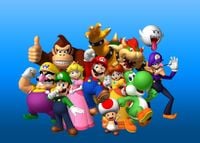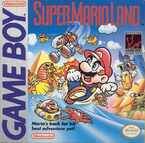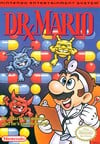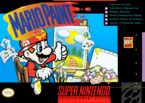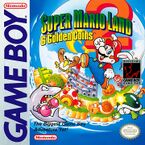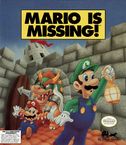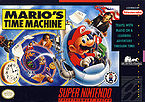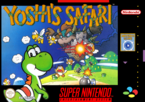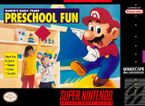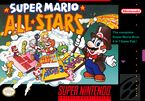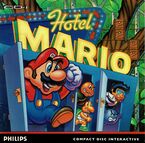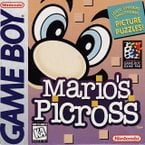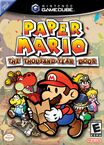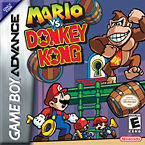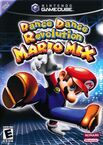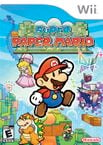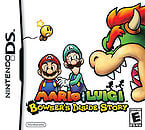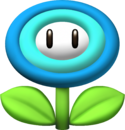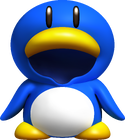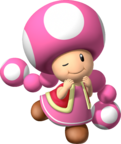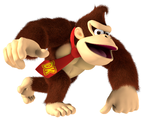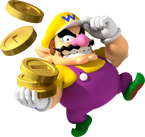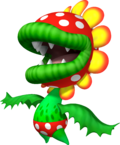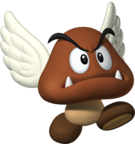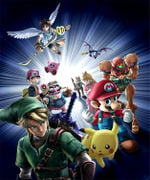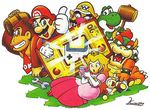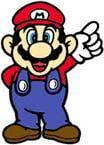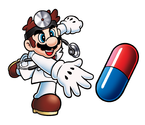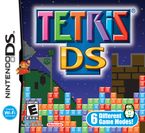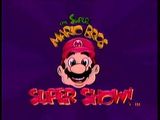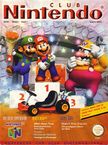Super Mario (franchise): Difference between revisions
Marcelagus (talk | contribs) (Higher quality) |
Justinhful (talk | contribs) No edit summary |
||
| Line 572: | Line 572: | ||
|<center>''[[Donkey Kong (game)|Donkey Kong]]''</center> | |<center>''[[Donkey Kong (game)|Donkey Kong]]''</center> | ||
|- | |- | ||
|} | !Diddy Kong | ||
---- | |||
[[Image:diddyDKJUNGLE.png|145x145px]] | |||
|[[Diddy Kong]] is [[Donkey Kong]]'s nephew and lives in the [[Kongo Jungle]].Diddy Kong made his debut in [[Donkey Kong Country]].Diddy Kong has also appeared through out Sports like [[Mario Golf: Toadstool Tour]] and [[Mario Superstar Baseball]] along with Donkey Kong.He also has a peanut popgun and rocket barrels in [[Donkey Kong 64]] and also has them in [[Super Smash Bros Brawl]].He even has his racing series called [[Diddy Kong Racing]] and this game features characters from other series. | |||
|<center>''[[Donkey Kong Country]]''</center> | |||
-} | |||
===Antagonists=== | ===Antagonists=== | ||
Revision as of 00:23, February 27, 2010
The Mario series is a long-running video game series published by the popular gaming company, Nintendo. The Mario series has been running for more than a quarter of a century, and in its lifespan has released more than two hundred video games.[1] The series started out in 1981, with the arcade video game, Donkey Kong, and has since then took off into it's own huge franchise. Originally created by Shigeru Miyamoto, Mario is the main protagonist throughout most of the series; the main antagonist of the series is Bowser, the King of all Koopas. The Mario series has contained many different genres of games, from platformers to role-playing games, and from puzzle games to party games. The most popular games in the series consist of what is known as the "main" series or the "Super Mario" series which consists of 2D and 3D platformers, at least one per home console and one per handheld (bar the Gameboy Advance and Virtual Console). The Mario series has been released on a large array of systems, including home consoles, handheld game systems, and even personal and Macintosh computers. Originally starting out with an 8-Bit game, the Mario series has gone through many graphical changes throughout the years. The series has spawned numerous sub-series, including the Mario Kart and Mario Party series; it has also taken a large part in the story line to it's partner series, Yoshi, Donkey Kong, and Wario.
Chronological Overview
1980-1989
| Title, Release and System | Synopsis and Ratings |
|---|---|
| Donkey Kong
|
In 1981, the Mario series had officially started with the release of Shigeru Miyamoto's creation -- Donkey Kong. Originally released in the arcades, Donkey Kong became a very popular game amongst gamers, eventually spawning many remakes and ports. In 1981, Mario had yet to be called so -- rather, he was called "Jumpman" during that brief era; it was only a few years later that Mario Segali would rename the aforementioned character to "Mario". Since then, the name has become very popular among the video game community; he is considered to be one of Nintendo's mascots. Since the release of Donkey Kong in 1981, Mario has appeared in over 200 games, and has been referenced in several more. |
| Template:ReleasedateArcade Machine | (Ratings unavailable) |
| Donkey Kong Jr.
|
One year later, in 1982, Mario – still "Jumpman" at the time – appeared as the antagonist of the game Donkey Kong Jr.. The story revolved around Donkey Kong's son, Donkey Kong Jr., saving his father from being trapped in a cage by Mario. Donkey Kong Jr. had to climb across many vines, avoiding several Snapjaws along the way. Eventually, after Donkey Kong Jr. collected several keys, he freed his father from his cage and defeated Mario. |
| Template:Releasedate Template:Releasedate Arcade Machine | (Ratings unavailable) |
| Mario Bros.
|
One year later, in 1983, Mario got his own game – using his current name. In the game Mario Bros., Mario and his brother Luigi – who first debuted in this game – were traversing the creature-infested depths of the sewers. Mario and Luigi had to fight such creatures as Shellcreepers and Sidesteppers; but with the help of a POW Block, things could get easier. |
| Template:ReleasedateArcade Machine | (Ratings unavailable) |
| Golf
|
Before the release of Super Mario Bros., Mario appeared in his first ever sports game: Golf — it was released in 1984. This game's gameplay is relatively simple: the player must strike the ball with the correct amount of force in order to get a good shot. The more good shots and the player gets, the more points he or she is likely to earn. Golf was the very first game in the Mario Golf series to ever be released. Mario was the only playable character, and even he is not seen in his traditional clothing. |
| Template:ReleasedateNES | (Ratings unavailable) |
| Wrecking Crew
|
In 1985, Nintendo released Wrecking Crew in Japan for the Famicom Disk System, then later that year for the NES. The concept of the game revolved around Mario (and Luigi, if a second player were to join the game) who were in the middle of a demolition site. While at the site, they had to break down all of the concrete walls with their hammers found in each level. The player would encounter several enemies, none of which could be defeated with the hammer that Mario (or Luigi) would carry. Rather, they would have to trap enemies under steel drums. The game also featured a new character: Foreman Spike. Foreman Spike would occasionally appear to outdo Mario at breaking down the concrete walls; furthermore, Foreman Spike could push Mario off of ledges. The game also featured a custom level creator, the first game in the Mario series to ever do so. |
| Template:ReleasedateFamicom | (Ratings unavailable) |
| Super Mario Bros.
|
In 1985, Mario starred in his very first game outside of the arcades. With the release of Super Mario Bros., the NES was an extreme success. Mario, and his brother Luigi, had to set out on a massive adventure across the Mushroom Kingdom to rescue Princess Toadstool and the Mushroom Retainers from the evil King Bowser Koopa. After traversing through eight massive worlds, filled with enemies, the brothers eventually reached Bowser's Castle, finally rescuing Princess Toadstool. Super Mario Bros. eventually became the best-selling video game for the NES in 1999.[2] |
| Template:ReleasedateNES | (Ratings unavailable) |
| Super Mario Bros.: The Lost Levels
|
After the extreme success of Super Mario Bros., Super Mario Bros.: The Lost Levels was released just one year later in Japan. The gameplay and story were almost identical to its predecessor, but it was not released in the United States due to its extreme difficulty.[3] Some gameplay elements were changed slightly, such as Bloopers flying in midair, wind to help the player jump across abysses, and other minor changes. |
| Template:ReleasedateFamicom | (Ratings unavailable) |
| Super Mario Bros. 2
|
Two years later in 1988, Nintendo released yet another Mario game for the NES – Super Mario Bros. 2. Despite the fact that the game's title has "2" in it, it was not the direct sequel to Super Mario Bros.— Super Mario Bros.: The Lost Levels was, however it was not released outside of Japan. In this game, Mario, Luigi, Princess Toadstool, and Toad had to save the dream world of Subcon from the diabolical Wart. After fighting their way through seven strange worlds, they eventually saved Subcon. Super Mario Bros. 2 would eventually be released in Japan as Super Mario USA. |
| Template:ReleasedateNES | (Ratings unavailable) |
| Super Mario Bros. 3
|
Another two years had passed by the time the next mainstream Mario game had been released: Super Mario Bros. 3. This was by far, the most expansive Mario game on the NES, as it featured many levels, items, and enemies. Bowser and his seven Koopalings wreaked havoc across the Mushroom World after turning all of the Mushroom Kings into various animals. Mario and Luigi had to traverse through many worlds, castles, seas, forests, and deserts to fix the wrongs the Koopalings had caused. Eventually, the Bros. reached Bowser and defeated him, rescuing Princess Toadstool once again. |
| Template:ReleasedateNES | (Ratings unavailable) |
| Super Mario Land
|
Mario made the jump to Nintendo's first handheld system in 1989, with the release of Super Mario Land. Selling a total of 18.06 million copies[4], it became the bestselling video game not to be bundled with a system in history. In this game, Mario had to traverse across the four worlds of Sarasaland to save the Princess Daisy from the alien Tatanga. With the help of new features such as the Superball, Marine Pop, and the Sky Pop, Mario was able to stop Tatanga and save Daisy. |
| Template:ReleasedateGame Boy | (Ratings unavailable) |
1990-1999
| Title, Release and System | Synopsis and Ratings |
|---|---|
| Super Mario World
|
One year after the release of Super Mario Bros. 3, Super Mario World had been released on a whole new home console — the Super Nintendo. It was with this game that the Mario series had been upgraded from 8-bit to 16-bit graphics. Though the games' graphics would later be revolutionized once again, this was indeed a huge step at the time. During the story of Super Mario World, while Mario, Luigi, and Princess Toadstool were vacationing in Dinosaur Land, Bowser and his seven Koopalings once again kidnapped the Princess. With the help of the Yoshis and Dolphins, the Bros. traversed across the vast area of Dinosaur Land. As they made their way to Princess Toadstool, they thwarted each Koopaling who stood in their way until they reached Bowser. Once again, Bowser had been defeated and Princess Toadstool had been rescued. |
| Template:ReleasedateSNES | (Ratings unavailable) |
| Dr. Mario
|
Dr. Mario was the first game in the Dr. Mario series; it was released for the NES in 1990. The game brought the basic concept of the series to the players' attention immediately, as they would start the game off having to reorganize falling Megavitamins in order to eradicate viruses from the screen. Once all viruses has been eliminated, the player would move on to the next level. As the game progressed, each level rose in difficulty, providing more viruses for the player to eliminate and less space to maneuver the Megavitamins in. Dr. Mario was ported and remade many times after its original release. |
| Template:ReleasedateNES | (Ratings unavailable) |
| Mario Paint
|
Released in 1992, Mario Paint was released for the SNES. The game was highly interactive, even utilizing the SNES Mouse. The game was the only one of its kind, thus it never spawned any sequels or games of similar style. The game's title screen was interactive, as each letter of the words 'Mario Paint' would cause a different effect on the title screen. In Art Mode, the player could draw several different creations on a canvas displayed on-screen; these drawings would have elements that were highly influenced from Super Mario World. The game also featured the ability to make Stamps, which were a type of sprite that the player could create in a separate game mode. In addition, the player could create their own music samples using the game's Music Mode. |
| Template:ReleasedateSNES | (Ratings unavailable) |
| Super Mario Land 2: Six Golden Coins
|
Three years later, Mario reappeared on the Game Boy with the release of Super Mario Land 2. Super Mario Land 2 was less popular than its predecessor[5], Super Mario Land. This story picked up right where the last one left off. After rescuing Princess Daisy, Mario returned to his castle, only to find that it had been taken over by his old nemesis, Wario. Mario must collect six golden coins scattered across Mario Land in order to regain access to his estate and defeat Wario. |
| Template:ReleasedateGame Boy | (Ratings unavailable) |
| Super Mario Kart
|
Over a decade ago, in 1992, the Mario Kart series had begun with the release of Super Mario Kart. It was one of the first games ever to be made that was 2-dimensional with 3-dimensional renderings. The game featured eight playable characters: Mario, Luigi, Princess Toadstool, Yoshi, Toad, Bowser, Donkey Kong Jr., and Koopa Troopa. Though the player could not pick from a selection of karts, each character was pre-assigned with a kart, each with a different weight, speed, and acceleration. This game was also heavily influenced by Super Mario World, as many of the racecourses took place somewhere within the borders of Dinosaur Land; the game also featured the Cape Feather, which was found in Super Mario World. |
| Template:ReleasedateSNES | (Ratings unavailable) |
| Mario is Missing!
|
In 1992, Nintendo released their first ever Mario edutainment game: Mario is Missing!. The game was originally released for MS-DOS, but was later released on the NES, SNES, and then released agaiun on the PC. The game was also the first to feature Luigi as the main playable protagonist. The story revolves around Bowser, who has kidnapped Mario and taken him to his fortress in Antarctica. Bowser then plans to steal several shipments of hair dryers in order to melt the icy continent and flood the world. Luigi must then travel through several locations on Earth in order to retrieve several artifacts to help him rescue his brother. The game was designed to be simple in battle, as the enemies and bosses found throughout the game could not harm the player. |
| Template:ReleasedateMS-DOS | (Ratings unavailable) |
| Mario's Time Machine
|
Mario's Time Machine is yet another edutainment game in the Mario series. It was released in 1993 for NES, SNES, and PC. The game is an attempt to teach children various aspects of world history. As such, Mario must use his time machine to travel throughout various time periods in history, dating back to 80,000,000 B.C., all the way up to 1989 A.D.. Mario must collect artifacts from each period of time he visits in order to progress through the game. Should the player fail at retrieving the artifacts in the wrong order, the ending will show Bowser escaping to Paradise, requiring the player to start the game over completely; however, if the game is completed in an orderly fashion, the player will win the game. This game is also notable for being the first and only game in the Mario series that has Mario speaking in full phrases. |
| Template:ReleasedateSNES | (Ratings unavailable) |
| Mario & Wario
|
Mario & Wario is a puzzle game released for the Super Famicom in 1993; it was released only in Japan. The game featured three different modes of difficulty and ten levels in which the player had to guide Peach (easy), Mario (intermediate), or Yoshi (hard) to reach Luigi, who is the goal of each level. After Wario drops a random item on the player's head, be it a bucket or a jellyfish, Wanda the fairy must then help guide the player to Luigi in order to advance to the next level. The game was one of the very few to utilize the SNES Mouse. |
| Template:ReleasedateSuper Famicom | (Ratings unavailable) |
| Yoshi's Safari
|
In 1993, Nintendo released Yoshi's Safari for the SNES. The game carried over many aspects of Super Mario World, featuring many of the same bosses and enemies (such as Chargin' Chucks), and having Mario ride Yoshi throughout the game. Yoshi's Safari is notable for being the only shooter in the Mario series, utilizing the Super Scope to facilitate gameplay. The story revolved around Mario and Yoshi traveling through the vast realms of Jewelry Land. Their mission was to save King Fret and his son, Prince Pine, from the diabolical Koopalings who were terrorizing the land. |
| Template:ReleasedateSNES | (Ratings unavailable) |
| Mario's Early Years! Preschool Fun
|
In 1993, Nintendo released the first installment of the Mario's Early Years! edutainment sub-series: Mario's Early Years! Preschool Fun. The game revolved around Mario, Princess Toadstool, and Yoshi, who were all separated by a terrifying storm. The player had to then control the three and reunite them. The three had to travel through many worlds; each world would teach its player something fundamental, yet completely different from the last lesson. The player would learn about shapes, numbers, sounds, and colors whilst playing the game. |
| Template:ReleasedateSNES | (Ratings unavailable) |
| Wario's Woods
|
Wario's Woods is a puzzle game released originally for the SNES in 1993; it was later released for the NES in 1994. The game features Toad as the main protagonist, the only Mario game to ever do so. As Toad was out walking one day, he accidentally ran into a large forest owned by the evil Wario. Wario was sending out many of his monsters to attack the Mushroom Kingdom. With the help of Birdo and Wanda, Toad had to protect the Mushroom Kingdom from the monsters' inevitable infiltration. |
| Template:ReleasedateSNES | (Ratings unavailable) |
| Super Mario All-Stars
|
In 1993, a compilation of NES Super Mario Bros. games had been released. The game was titled Super Mario All-Stars. The game contained Super Mario Bros., Super Mario Bros.: The Lost Levels, (which was the first U.S. release of that game), Super Mario Bros. 2, and Super Mario Bros. 3. The games featured updated graphics to fit the 16-bit memory of the Super Nintendo. Not many other changes had been made to the games. One year later, in 1994, a second installment called Super Mario All-Stars + Super Mario World had been released. As its name implies, it has all the previously mentioned NES games as well as the addition of Super Mario World. |
| Template:ReleasedateSNES | (Ratings unavailable) |
| Hotel Mario
|
In 1994, Hotel Mario was released for the Philips CD-i, and was developed by Philips Media. The game was rather obscure and received very little attention due to the lack of interest in the Philips CD-i. The plot deals with Bowser and his seven children, the Koopalings, who have once again taken over the Mushroom Kingdom; this time, they built a series of hotels, of which, one is hiding Princess Peach. Once Mario and Luigi become aware of this, they set out on a mission to stop Bowser and his children once more and rescue the Princess. The main goal of each stage is to close all of the doors on each floor in order to progress to the next stage or location. However, enemies commonly interfere with the player's goal, thus reopening the doors, requiring them to be closed once more. The name of each hotel is a portmanteau on a Real World hotel, such as the Ritz Carlton hotel. |
| Template:ReleasedatePhilips CD-i | (Ratings unavailable) |
| Mario's Picross
|
In 1995, Nintendo released Mario's Picross for the Game Boy. Mario's Picross was a puzzle game that spawned a sub-series containing two additional games: Picross 2 and Super Mario Picross. The game featured a paint-by-numbers puzzle system, in which there was a 100-square screen for the player to maneuver around. Once the puzzle was completed, the player would advance to the next one, which would increase in difficulty somewhat. A total of 192 puzzles could be found in the game, found throughout three different modes: Easy Picross, Kinoko, and Star — each of which contained 64 puzzles. There was also a time-trial mode, which contained 64 puzzles, (that were previously beaten), that would appear at random. |
| Template:ReleasedateGame Boy | (Ratings unavailable) |
| Super Mario World 2: Yoshi's Island
|
Four years after the release of Super Mario World, its sequel — which takes place before the events of Super Mario World — was released. Super Mario World 2: Yoshi's Island marked the start of theYoshi series by telling the events that occurred when the Yoshis first met Mario when he was a baby. After Kamek had kidnapped Baby Luigi, (and had also attempted to kidnap Baby Mario), Baby Mario fell onto Yoshi's Island. After a Yoshi had picked up Baby Mario, it decided to help him find his brother before he was harmed by the evil Kamek. This story would not be continued until eleven years later with the release of Yoshi's Island DS. |
| Template:ReleasedateSNES | (Ratings unavailable) |
| Mario's Tennis
|
In 1995, the first installment to the Mario Tennis series was released —Mario's Tennis. It inspired the creation of several more games in the series, (the next being Mario Tennis for the Nintendo 64). The game had seven playable characters, all of which were featured in Super Mario Kart, with the exception of Bowser who did not appear in this game. |
| Template:ReleasedateVirtual Boy | (Ratings unavailable) |
| Super Mario RPG: Legend of the Seven Stars
|
The first Mario RPG to be made was one of the last Super Nintendo games to be released — Super Mario RPG: Legend of the Seven Stars. To many, it was a success, as it received great reviews amongst players.[6] This Mario game also introduced the turn-based battle system to the series. HP, Speed, Attack, Defense, Magic Attack, and Magic Defense were all features that Mario, his partners, and enemies all carried. In the story, Princess Toadstool was kidnapped once again by King Bowser; Mario set off on a brief adventure to rescue her. After battling Bowser, Mario did not get the chance to fully rescue the princess. A large sword fell from the sky and plummeted straight into Bowser's Castle, destroying the Star Road, while sending the three into different directions. After Mario wakes up back in the Mushroom Kingdom, he sets out on an adventure to find out what happened all the while still having to rescue Princess Toadstool. Along his journey, Mario meets characters such as Mallow and Geno, all of whom join him in hopes of defeating Smithy, the cause of the Mushroom Kingdom's current state. This is the first game in which Bowser allied with Mario, and in which Bowser and Princess Toadstool were playable characters. |
| Template:ReleasedateSNES | (Ratings unavailable) |
| Super Mario 64
|
Not long after the release of Super Mario RPG: Legend of the Seven Stars, Nintendo released a new system and a new game — Super Mario 64. The game was a success. It was the first fully 3-Dimensional Mario game to ever be made, thus revolutionizing the appearance of Mario games to date. The game sold over eleven million copies by 2007.[7] Because the game had such amazing success, people began to create rumors of glitches[8] and unlockables in the game. Perhaps one of the most notable rumors of the game was that Luigi was a playable character in the game, somehow able to be unlocked.[9] This was also the second game to call Princess Peach by her current name (with Yoshi's Safari being the first). In the game, Mario was invited to Princess Peach's Castle to eat a cake she had baked. However, when Mario arrived at her castle, he had discovered that Bowser had taken it over and had stolen almost all of the castle's Power Stars— there were some which he did not know existed. As Mario traversed through fifteen different painting worlds, he eventually recovered enough Power Stars to battle Bowser and take back the castle, freeing Peach from her stained-glass prison. |
| Template:ReleasedateNintendo 64 | Gamespot – 9.4: Superb |
| Wrecking Crew '98
|
In 1998, Wrecking Crew '98, the Japan-only sequel to Wrecking Crew was released. The game had similar mechanics to that of it's prequel, as the player had to line up panels in a color-coded manner in order to get rid of them; there was also the option to smash them with a hammer. The game also featured the ability to rain a large amount of panels on the opponent, causing them to have more difficulty clearing the stage. The story tells that Mario, on his way home, discovers Bowser on a campaign to build several high-rises in the Mushroom Kingdom, which are destroying the plant life of the area. As Mario attempts to trump Bowser's plot, he must fight his old nemesis, Foreman Spike, along with other villains such as Eggplant Man. |
| Template:ReleasedateSuper Famicom | (Ratings unavailable) |
| Mario Party
|
In 1999, Nintendo released the first Mario Party game to ever be made — Mario Party. The game was a whole new aspect on multi-player capabilities in the Mario series; most games up until now mainly featured a 2-player versus mode, with the exceptions of a few sports spin-offs. The game mechanics worked near-identically to that of a board game: players would rove around the board, moving from space to space, and hitting a Dice Block in order to move said spaces. The players could earn coins by playing and winning mini-games; with a certain amount of coins, the players could by stars. Despite the fact that this was a party game, it also had a single-player mode, in which the player would play against CPUs. There were six playable characters in the game: Mario, Luigi, Peach, Donkey Kong, Yoshi, and Wario. Each character had one board modeled after them, in addition to two other boards in the game — one dedicated to the game's antagonist, Bowser, and the other unlockable after collection one-hundred stars. |
| Template:ReleasedateNintendo 64 | Gamespot – 7.2: Good |
| Super Mario Bros. Deluxe
|
In that same year, Nintendo released another hit, Super Mario Bros. Deluxe. It sold a total of 2.8 million copies in the United States alone.[10] The game was one of the highest rated games according to Gamespot and IGN. This game, though for the Game Boy Color (which didn't have particularly long or large games), had many features and unlockables. It featured two games in one – Super Mario Bros. and The Lost Levels. This was only the second time that The Lost Levels had been released in the United States. There were also many unlockables such as You vs. Boo, a Yoshi Egg Finder, a Calendar, a Photo Album and much more. A multiplayer mode was also available, which was very similar to the You vs. Boo mode. |
| Template:ReleasedateGame Boy Color | IGN – 10: Masterful • Gamespot – 9.9: Superb |
2000-2009
| Title, Release and System | Synopsis and Ratings |
|---|---|
| Paper Mario
|
After another two years had passed, Nintendo released another Mario game — Paper Mario. It was the first Mario role-playing game since the release of Super Mario RPG for the Super Nintendo. Paper Mario brought up a whole new concept for graphics in the Mario series, as everything in the game was made to look as if it were made out of paper. Once again, Mario had to set out on a long mission to save Princess Peach from Bowser. As Mario set out on his adventure, he met citizens of various villages that wanted to assist him on his journey, the first of which was Goombario. At the end of each chapter, Mario and his partners would fight a boss, eventually leading to the freedom of a Star Spirit. When Mario and his partners had freed all of the Star Spirits, they were prepared to fight Bowser. After an epic two-part battle with Bowser, Mario eventually rescued Princess Peach from her current fate. Paper Mario is the only Mario role-playing game to date in which Bowser acts as the main antagonist; in all other Mario role-playing games, Bowser has either taken the role of an ally, or as a somewhat minor antagonist. Paper Mario has inspired two sequels to date — Paper Mario: The Thousand-Year Door and Super Paper Mario. |
| Template:ReleasedateNintendo 64 | IGN – 9.0: Outstanding • Gamespot – 9.5: Superb |
| Luigi's Mansion
|
In 2001, Nintendo released the GameCube, their first 128-bit System. The first Mario game to be released on the GameCube was Luigi's Mansion; it was one its few launch titles. The game was the first ever to star Luigi as the main protagonist in the game; all other games prior to this one had Luigi portrayed as a sidekick or some sort, or off on his own mission. At the beginning of the game, Luigi is shown walking up to the large mansion that he won in a contest. Inside the mansion, Luigi encounters a few unfriendly beings, only to be saved by Professor Elvin Gadd. The Professor tells Luigi that the mansion is haunted with hundreds of ghost, and sends him in to stop them in hopes of rescuing Mario. As Luigi passes through the various rooms of the house, eliminating ghosts with the Poltergust 3000, he eventually runs across some of Mario items: His hat, his shoe, his glove, and his star. After taking them to a ghostly fortune teller, Luigi discovers that Mario is indeed still alive and is being held captive by the Boos. Thus, Luigi travels forth more, ridding the mansion of any Boos along the way. Eventually, he finds King Boo's lair, finding Mario trapped within a painting frame. Luigi is whisked away to the mansion's roof, where he battles King Boo and its huge Bowser suit. After defeating King Boo, Luigi takes the framed Mario back to E. Gadd's lab, where he is soon thereafter freed. |
| Template:ReleasedateGameCube | IGN – 7.0: Decent • Gamespot – 7.9: Good |
| Super Mario Sunshine
|
In 2002, Mario was back in action in his own three-dimensional platformer once again. While on his way to a vacation with Princess Peach and her loyal steward, Toadsworth, they find a large glob of graffiti in the shape of Mario's head on their landing strip. Mario then finds an interesting machine, called F.L.U.D.D., that helps him rid the island of graffiti. After he collects a total of ten Shine Sprites, an impostor bearing a striking resemblance to Mario kidnaps Princess Peach. Mario then must redeem his identity (because of Shadow Mario), by ridding the entire island of graffiti, all the while having to rescue Princess Peach. Towards the end of his adventure, he discovers that Shadow Mario is actually Bowser Jr. in disguise. After fighting Bowser and his son, Mario rescues Princess Peach, finally allowing them to finish their vacation. |
| Template:ReleasedateGameCube | IGN – 9.4: Outstanding • Gamespot – 8.0: Great |
| Mario & Luigi: Superstar Saga
|
Towards the end of 2003, Nintendo released a huge Mario hit for the Game Boy Advance — Mario & Luigi: Superstar Saga. The game was the first Mario role-playing game to ever be released on a handheld system. The game featured Mario and Luigi, both being playable at the same time. After the evil Cackletta and her henchman Fawful infiltrated Princess Peach's Castle, they stole Princess Peach's voice in order to help dominate the world. Soon thereafter, the Mario Bros. head off for the Beanbean Kingdom. After much traversing, through the borders and Hoohoo Village, they eventually reached Beanbean Castle Town. When they enter the borders of the city, they find it in ruins. As they reach Beanbean Castle, they find that it too had been terrorized, and that Queen Bean was not herself. After battling her, the Bros. set out on an additional mission to find all of the pieces of the Beanstar. After a long journey through the Mushroom World, they eventually reached Bowser's Castle, where Cackletta's Spirit was hiding out; her. It was a tiresome and fierce battle, but the Bros. prevailed as always. The Princess was saved, and the Beanstar had been retrieved. All was back to normal once again...or at least as normal as things got for Mario and his friends. This game eventually had a sequel for the Nintendo DS, Mario & Luigi: Partners in Time and another one in 2009, called Mario & Luigi: Bowser's Inside Story. |
| Template:ReleasedateGame Boy Advance | IGN – 9.0: Outstanding • Gamespot 9.2: Superb |
| Paper Mario: The Thousand-Year Door
|
In 2004, Nintendo released the indirect sequel to Paper Mario —Paper Mario:The Thousand-Year Door. The game was a huge hit, reaching Player's Choice status. The story starts out with Princess Peach in a mysterious town, called Rogueport, looking through someone's rummage sale. She vanishes soon thereafter. After receiving a letter from Princess Peach — mailed before she went missing — Mario sets off on a trip to Rogueport. After arriving there, he finds Toadsworth. To his dismay, Princess Peach mysteriously vanished from Rogueport. So, Mario and his current partner set out on a journey to save Princess Peach, and retrieve the seven Crystal Stars. After a long journey, Mario and his partners set the final Crystal Star in the Thousand-Year Door, they finally unlocked the entrance to the Palace of Shadow — a dark place locked away for an entire millennium. After fighting Sir Grodus, leader of the Secret Society of the X-Nauts, they fought the demonic Shadow Queen. After possessing Peach, the Shadow Queen revealed her true form and battle Mario and his partners. The battle was enormous, and required the motivation of people from across the Mushroom Kingdom to win. The Shadow Queen was defeated, and Rogueport and all surrounding areas were able to relax and return to their lives. Two years later, Super Paper Mario was released for the Wii. It wasn't the direct sequel to this game, but it continued the adventures of Mario in his paper form. |
| Template:ReleasedateGameCube | IGN – 9.1: Outstanding • Gamespot – 9.2: Superb |
| Mario vs. Donkey Kong
|
Released in 2004, Mario vs. Donkey Kong was a game for the Game Boy Advance. As its name would imply, it revolves around the concept of Mario fighting Donkey Kong. The game had a similar concept to that of Donkey Kong. After Donkey Kong had seen an advertisement on television for miniature Mario toys, he went to the store to purchase some. Since the store was out of stock, Donkey Kong raided the toy factory and stole all of their Mini Mario toys. Because of a hole in the bag in which he was storing the toys, the toys all fell out. Mario, the three Toad factory employees, and all the toys began to mock Donkey Kong. Thus, Donkey Kong kidnapped the three Toads and climbs atop the factory. It is then up to Mario to rescue the Toads. |
| Template:ReleasedateGame Boy Advance | IGN – 8.5: Great • Gamespot – 8.0: Great |
| Dance Dance Revolution: Mario Mix
|
In 2005, Nintendo released the first and only Mario rhythm game: Dance Dance Revolution: Mario Mix. The game was a Mario edition of the popular Dance Dance Revolution series produced by Konami. The game featured Waluigi as the main antagonist, who had stolen all of the Music Keys from Truffle Tower. Toad then informs Mario of Waluigi's mischief; Mario then sets out on a mission to retrieve the Music Keys back from him. Mario must then visit various locations, dancing to remixes of Mario themes in order to proceed to the next location. The game had five levels of difficulty; the hardest of which contained more than 200 steps in each song. |
| Template:ReleasedateGameCube | IGN – 8.0: Impressive • Gamespot – 7.0: Good |
| Mario & Luigi: Partners in Time
|
In 2005, Nintendo released the sequel to Mario & Luigi: Superstar Saga; it was titled Mario & Luigi: Partners in Time. The game once again allowed Mario and Luigi to be playable at the same time, but it also allowed newcomers to the Mario & Luigi series — Baby Mario and Baby Luigi — to be playable as well. The story revolved around the invasion of the Mushroom Kingdom by a group of extraterrestrial terrorists, known as the Shroobs. The Shroobs had invaded the past and was quickly taking over all of the Mushroom Kingdom. Mario and Luigi, after teaming up with their infant selves, were eventually able to stop this catastrophe after defeating Princess Shroob and Elder Princess Shroob. The invasion immediately went into retreat and the Mushroom Kingdom returned to its normal self, thanks once again to the Mario Bros. |
| Template:ReleasedateNintendo DS | IGN – 9.0: Outstanding • Gamespot – 8.9: Great |
| Super Princess Peach
|
Released in 2005, Super Princess Peach is a platformer for the Nintendo DS. As its title would imply, Princess Peach is the main protagonist. The story is of Bowser sending a large army of his minions to infiltrate Princess Peach's Castle. Because she is not there at the time of the attack, Mario, Luigi, and several of the castle's Toads are kidnapped. Princess Peach must then set out on a long journey — along with her helpful parasol, Perry — in order to rescue those who had been kidnapped and stop Bowser from using his ultimate weapon: the Vibe Scepter, which is capable of making creatures feel emotions and transforming them to fit their feelings. Super Princess Peach featured many extras; among them were three mini-games in which the player had to use the stylus to control Toad. There were also puzzles — only unlocked after all the Puzzle Pieces had been retrieved. Lastly, there were several songs from the game that Princess Peach could collect; these songs would later be played by Peach's band, the Peach Hit Five. |
| Template:ReleasedateDS | IGN – 7.8: Good • Gamespot – 7.2: Good |
| New Super Mario Bros.
|
This newest installment of the Super Mario Bros. sub-series was released for the Nintendo DS in 2006. New Super Mario Bros. was the first 3-dimensional sidescroller ever in the Super Mario Bros. series. The story revolves around Mario and Luigi, who, once again, are out to rescue Princess Peach; this time from Bowser Jr. The Mario Bros. had to travel through several worlds full of Bowser's minions in order to finally rescue the Princess. This game marked the debut of Bowser's skeletal form, Dry Bowser. The game featured a two-player wi-fi mode, in which the Mario Bros. would endure races through various levels. |
| Template:ReleasedateDS | IGN – 9.5: Incredible • Gamespot – 9.0: Superb |
| Super Paper Mario
|
Nintendo released yet another installment in the Paper Mario series in 2007, with the release of Super Paper Mario. The game introduced a whole other dimension to the series with Mario having the ability to flip between the second and third dimensions. This new feature was commonly required to pass up various road blocks or to defeat enemies throughout it's eight chapters. The story revolves around Count Bleck, an evil mastermind that plans to destroy not only the Mushroom World, but all worlds and dimensions in existence. After reading a prophecy in the Dark Prognosticus, he had already devised a plan on how to do so. Thus, Mario, Luigi, Princess Peach, and even Bowser teamed up, (with the help of many Pixls), to help stop Count Bleck and his vile plans. However, to do so, Mario and his friends had to collect all eight Pure Hearts in order to even have a chance to stop Count Bleck. |
| Template:ReleasedateWii | IGN – 8.9: Great • Gamespot – 8.8: Great |
| Super Mario Galaxy
|
The latest main installment into the Mario platformer series was released by Nintendo in the end of 2007. Super Mario Galaxy for the Wii was an adventure on galactic proportions. The story is told that every hundred years, a comet soars over the Mushroom Kingdom, raining stars down upon the land. Princess Peach invites Mario to her castle to join in on the festivities, only to have Bowser and Bowser Jr. his son crash the party. Bowser once again kidnaps Peach, but orders a Magikoopa to send Mario into a small planetoid. Mario then has to bounce from galaxy to galaxy, collecting Power Stars along his way. After encountering Rosalina and her Lumas, Mario learns that he needs to collect the Grand Stars in order to stop Bowser from completing his plan – creating a new galaxy. The game introduces many new items to help Mario along his journey, including the Boo Mushroom, Bee Mushroom, Ice Flower and many more. Super Mario Galaxy has a few similarities to Super Mario 64, including the fact that Mario must travel to various locations — this time galaxies instead of painting worlds — in order to defeat Bowser. |
| Template:ReleasedateWii | IGN – 9.7: Outstanding • Gamespot – 9.5: Superb |
| Mario & Luigi: Bowser's Inside Story
|
In 2009, another sequel of the Mario & Luigi series was released for the Nintendo DS. In this installment, an epidemic called The Blorbs swept across the Mushroom Kingdom, and it's up to Mario and Luigi to find a cure. However, determined to defeat the Marios, Bowser seeks help from Fawful, where he eats a "Lucky Mushroom." The mushroom gives Bowser the ability to inhale with great force. Bowser uses this ability to consume the Mushroom Kingdom, citizens and all. Throughout the adventure, Bowser realized he was used by Fawful, and in retaliation, goes off to stop his evil scheme. Meanwhile, Mario and Luigi, being inside Bowser's body, does whatever it takes to help Bowser in his quest, by messing with Bowser's insides to affect Bowser in a good way. This is the first time an RPG was created for the same platform as its predecessor. This also marks the first time Bowser is playable in the series. |
| Template:ReleasedateDS | IGN – 9.5: Incredible • Gamespot – 9.0: Superb |
| New Super Mario Bros. Wii
|
The sequel to New Super Mario Bros. for the DS, New Super Mario Bros. was released in November 12, 2009 in Austrailia. This installment includes 4 players simentaneously controlling their characters, a feature Shigeru Miyamoto had wanted for years. This game also returns the Koopalings, absent since Mario and Luigi: Superstar Saga, in their first 3-D models. In the story, Bowser and his minions kidnap Peach by using cake as a disguise. Mario, Luigi, Blue Toad, and Yellow Toad travel to 8 worlds to save the princess. This game also reintroduces rideable Yoshis, although they can only be ridden in a few levels. The Penguin Suit and the Propeller Mushroom are new power-ups in this game. This game also includes the Super Guide, a demo video for those who are struggling in a particular level. |
| Template:ReleasedateWii | (Ratings unavailable) |
Items
| Name | Description | First Appearance |
|---|---|---|
| Super Mushroom
|
The Super Mushroom is a small, red Mushroom with white spots. It is the most common type of Mushroom found throughout the Mushroom World. The Super Mushroom has the ability to make whatever it touches grow in size, sometimes increasing said being's strength. Mario and Luigi have commonly used Super Mushrooms throughout their many adventures in order to help them survive. In Mario platformers, the Super Mushroom generally increases the size of the Mario Bros. by a minimal amount; this change in size is just enough to allow the Bros. to break Brick Blocks. In Mario role-playing games, Super Mushrooms generally heal Mario or his partners by partially refilling their HP. | |
| 1-Up Mushroom
|
The 1-Up Mushroom is an item that is similar in appearance, but entirely different in effect to the Super Mushroom. 1-Up Mushrooms are green in color, with white spots. They are the same size as Super Mushrooms, and share the same facial features. 1-Up Mushrooms grant Mario and others to gain an extra life when they touch or eat it. 1-Up Mushrooms can be found hidden in blocks, behind items, guarded by enemies, within chests, or any number of other locations. 1-Up Mushrooms are much less common than Super Mushrooms, appearing roughly once per level, whereas Super Mushrooms appear several times in a level. In Paper Mario games, 1-Up Mushrooms don't exist; rather, there is the Ultra Shroom, which looks strikingly similar to a 1-Up Mushroom. | |
| Poison Mushroom
|
Debuting in Super Mario Bros.: The Lost Levels, Poison Mushrooms are Mushrooms that, as their name suggests, harm whatever they touch. In platformers such as Super Mario Bros.: The Lost Levels and Luigi's Mansion, Poison Mushrooms will shrink the player if he or she comes in direct contact with one. In Super Mario Kart, Princess Toadstool and Toad could throw these at opposing racers, shrinking them drastically in size; when an opponent shrank, they could easily be run over and thrown off-track. In the Mario Party series, Poison Mushrooms appear once again; however, here they effect how many spaces the player can move. In Mario role-playing games, Poison Shrooms harm Mario or his partners by decreasing their HP greatly. | |
| Mini Mushroom
|
Debuting in Super Mario Kart in 1992, Mini Mushrooms are a small type of Mushroom. They have appeared in three games, and in one, they were used as a weapon against opponents. They first appeared in Mario Party 4. Here, the player could use them to gain access to certain areas of the game boards. In Mario Pinball Land, Mini Mushrooms were used to squeeze inside small locations to retrieve Power Stars. Their latest appearance was in New Super Mario Bros., in which their color scheme changes drastically from the original pink, to the new blue with white spots. Mini Mushrooms held the same effect, allowing Mario or Luigi to fit in tiny pipes to retrieve certain items. | |
| Mega Mushroom
|
First appearing in Mario Party 4, Mega Mushrooms were pale green in color with white spots; they were slightly larger than most other Mushrooms, but still had similar facial features. Mega Mushrooms would grant anyone who used them the power to grow enormous in size, as well as use two Dice Blocks. If the player crushed an opponent while walking across the board, he or she would receive ten coins for doing so. Mega Mushrooms later appear in New Super Mario Bros. with a new design; they were large, yellow mushrooms with vibrant red spots. Here they grant Mario or Luigi the ability to be huge in size and invincible from all harm, (with the exception of falling into an abyss. This is the one of the two items from New Super Mario Bros., along with the Blue Shell that was not reused for New Super Mario Bros. Wii, it's successor. A Goomba also touched a Mega Mushroom in the game, becoming the boss of the fourth world: Mega Goomba. In Mario Kart Wii, Mega Mushrooms acted similar to the way they did in Mario Party 4, only the player would not receive coins for running over opponents. | |
| Fire Flower
|
Debuting in Super Mario Bros., Fire Flowers are a type of plant that grant whoever touches one the ability to throw fireballs. When Mario or Luigi would touch a Fire Flower, they would turn into their fire form, with the traditional white shirt and hat, and red or green overalls respectively, being able to sling fireballs at incoming enemies. Fireballs are sometimes the most effective way to eliminate enemies, as very few are immune to them; Buzzy Beetles are one of these exceptions. In Super Mario World Fire Flowers went through a design change, appearing to be more like orange tulips with happy eyes. In the Paper Mario series, Fire Flowers can be used both as weapons against enemies, and as an ingredient into several different recipes, (including the Spicy Soup). | |
| Ice Flower
|
The Ice Flower debuted in Super Mario Galaxy, allowing Mario to turn into a transparent Ice Mario, with the ability to throw ice balls, just the opposite of Fire Mario. He also has the ability to freeze water and lava when stepped on. The Ice Flower also made a more prominent appearance in New Super Mario Bros. Wii, being similar in purpose to Super Mario Galaxy, where Mario and Luigi were playable, except nether one transparent, having a light blue shirt and hat, and red or green overalls respectively, and neither one has the ability to walk on water or lava anymore. | |
| Penguin Suit
|
The Penguin Suit made it's first appearance in New Super Mario Bros. Wii serving a similar purpose to that of the Frog Suit in Super Mario Bros. 3, Mario or Luigi would appear in this suit with the abilities to throw snowballs that freeze enemies, have traction and slide on his belly on slick surfaces, but most importantly he can swim much more fluent then any other form that Mario has. | |
| Propeller Mushroom
|
The Propeller Mushroom debuted in New Super Mario Bros. Wii. This power up is pretty straightforward and loosely based off of Cape Mario from Super Mario World or even farther back Raccoon Mario from Super Mario Bros. 3, all three having the ability to fly for short periods of time. Mario or Luigi would gain a red or green suit respectively with a propeller on the helmet causing them to propel into the air and slowly spin down or have the option to corkscrew strait down. | |
| Star
|
Originally called "Starman", Stars are a powerful celestial object found commonly throughout the Mario series. Stars debuted in Super Mario Bros. Whenever Mario or Luigi touch a Star, they become almost entirely invincible — the only things that can still end their game is to either fall into an abyss, or to get squished. While using the Star, they can defeat any enemy instantly with one touch. However, the effect of the Star lasts for a relatively short time. The theme music of the effect eventually was used in most Mario games, though sometimes the theme would get remixed. Super Mario Land's Star theme music was the famous Can-Can music, but Super Mario Land 2: Six Golden Coins used an entirely different melody. In Super Mario Kart and other Mario Kart games, this item was one of the rarest ones received, which of course gave the user invincibility, as well as the ability to knock other racers aside. This item was replaced by the Rainbow Star in Super Mario Galaxy, but it returned in Mario Kart Wii. | |
| Coin
|
First appearing in the arcade game, Mario Bros., Coins are a form of currency in the Mushroom World. In the Super Mario Bros. series of platformers, when collected, they will award the player with a total of one-hundred points per coin; also, after collecting one-hundred coins, the player would earn an extra life. In Super Mario 64, there were three different types of Coins: Yellow Coins, Blue Coins, and Red Coins. Yellow Coins played a much more vital part in completion of the game. By collecting coins, the player's HP meter will refill by one notch; also, if the player collects one-hundred coins on a stage, he or she will be awarded with an secret Power Star, which is vital to entirely completing the game. In Mario RPGs, Coins act as a form of currency to purchase items, weapons, badges, and other things that are useful along Mario's journey. |
Objects
| Name | Description | First Appearance |
|---|---|---|
| Brick
|
Perhaps one of the most common type of Blocks found throughout the Mario series is the Brick Block. First appearing in Super Mario Bros., Brick Blocks can only be broke by Super Mario or Super Luigi; they can only achieve this status after they have used a Super Mushroom. Some Brick Blocks turn out to hold many coins for the player to collect and add to his or her point total. Brick Blocks are also know to secretly contain power-ups and 1-Up Mushrooms. Brick Blocks also sometimes provide a bridge for the player to walk across abysses. Beanstalks also can be found hidden within certain Brick Blocks, allowing the player access to a Coin Heaven. Certain switches can also be unveiled from a Brick Block; this can sometimes be vital to completing a level, depending on whether or not said switch activates an event that helps the player gain further access in the level. | |
| ? Block
|
Debuting in Super Mario Bros., the ? Block provides the player with many things. Super Mushrooms, Fire Flowers, and Coins can all be received by hitting a ? Block in the game. In Super Mario 3 and in Super Mario World, there was also the possibility that a Switch would pop out of the block. In Super Mario 64, ? Blocks are replaced with ? Switches. In order for Mario to get his Wing Cap, he must find the ? Switch hidden in thecastle and press it. ? Blocks also appear in Paper Mario: The Thousand-Year Door; here, they are seen only during the chapter intermissions in which the player controls Bowser. These ? Blocks contain Meat, which help Bowser to grow in size and become more powerful. In Super Mario Galaxy, ? Blocks hold Star Bits within them. Item Boxes from the Mario Kart series have an appearance similar to ? Blocks, only they have a transparent color. Another similar object is the ! Block. | |
| Warp Pipe
|
Throughout the Mushroom Kingdom, Warp Pipes are used as the primary way of transportation. Debuting in Mario Bros., Warp Pipes would randomly eject various enemies for the player to defeat or avoid. In Super Mario Bros., Warp Pipes had a much more noticeable role. While they provided access to secret underground areas that often hosted mass amounts of Coins, they also were commonly clogged with Piranha Plants. On occasion, the player would have to use Warp Pipes as platforms to traverse from one area of a level to another. In Super Mario Bros. 3, Warp Pipes served basically the same purpose. However, the seventh world of the game was a massive maze of Warp Pipes that the player had to maneuver through. Certain Warp Pipes would take the player further into the level, while others would send them backwards. In almost all main Mario games, and in most role-playing games, Warp Pipes serve exactly the same purpose. In Mario Party 7, there was the Warp Pipe Orb, which served as a road block; any player that would pass over the space it had been set on would be teleported to a previous location in the board. | |
| POW Block
|
Beginning from the Mario Bros. arcade game, POW Blocks have made great appearances in the Mario Series. One bump from under, and every enemy on the ground are stunned (For Shellcreepers, and later Spinys, is that very easy. But Sidesteppers first come in a bad mood, so must be done 2 times to stun. Fighter Flys can only be stunned on the ground, as mentioned before). However, the POW Block becomes flatter. It can be used 3 times, so players must use it wisely. In their debut, they appear in most phases. in Super Mario Bros. 2, they appear again, but are red instead. It can now be picked up, and can used once. This also defeats any enemy on the screen. In Super Mario World 2: Yoshi's Island, it appears, too, but enemies on the screen will change into Stars with feet, that can be counted to the counter. It also appears in every Paper Mario game, doing damage to all enemies in-battle. They also appear in Mario Kart Wii and Mario Kart: Arcade GP 2, but in comparison to the two mentioned games, the POW Block in those game work different to each other. Recently, they appear actually more than first. |
Major Characters and Species in the Mario Series
Protagonists
| Character | Brief Biography | First Appearance | ||||||||||||||||||||||||||||||||||||||||||||||||||||||||||||||||||||||||||||||||||||||||||||||||||||||||||||||||||||||||||||||||||||||||||||||||||||||||||||||||||||||||||||||||||||||||||||||||||||
|---|---|---|---|---|---|---|---|---|---|---|---|---|---|---|---|---|---|---|---|---|---|---|---|---|---|---|---|---|---|---|---|---|---|---|---|---|---|---|---|---|---|---|---|---|---|---|---|---|---|---|---|---|---|---|---|---|---|---|---|---|---|---|---|---|---|---|---|---|---|---|---|---|---|---|---|---|---|---|---|---|---|---|---|---|---|---|---|---|---|---|---|---|---|---|---|---|---|---|---|---|---|---|---|---|---|---|---|---|---|---|---|---|---|---|---|---|---|---|---|---|---|---|---|---|---|---|---|---|---|---|---|---|---|---|---|---|---|---|---|---|---|---|---|---|---|---|---|---|---|---|---|---|---|---|---|---|---|---|---|---|---|---|---|---|---|---|---|---|---|---|---|---|---|---|---|---|---|---|---|---|---|---|---|---|---|---|---|---|---|---|---|---|---|---|---|---|---|---|
| Mario
|
Mario is the main protagonist in his titular series of games. He made his debut in 1981, with the release of Donkey Kong for arcades across the world. Mario, (going by the name "Jumpman" in that game), had to fight his way through several mazy stages full of obstacles and enemies in order to rescue Pauline from the large ape, Donkey Kong. After that, Mario became largely popular, receiving another game for the arcade — Mario Bros.— and then several more games for the newly-developed home game console, the NES. Throughout almost thirty years, Mario has been the star of the largest game franchise Nintendo has published. Many characters have fought alongside Mario in his adventures in platformers and RPGs, but many have also fought against him during those times. Mario has gone through many physical changes, from his original 8-bit appearance, to his current 128-bit appearance. Mario commonly rescues Princess Peach, as well as several others, such as Mushroom Retainers, as his adventures continue. Mario has even been accepting enough to team up at times with his greatest foe; Bowser. | |||||||||||||||||||||||||||||||||||||||||||||||||||||||||||||||||||||||||||||||||||||||||||||||||||||||||||||||||||||||||||||||||||||||||||||||||||||||||||||||||||||||||||||||||||||||||||||||||||||
| Luigi
|
Luigi is Mario's taller, younger, twin brother. Luigi first debuted alongside Mario in Mario Bros. in 1983, fighting off the many enemies as a plumber. Luigi reappeared in Super Mario Bros. for the NES, playable only in the two-player mode of the game. He later appeared in Super Mario Bros. 2, being playable in one-player mode for the first time along with Toad and Peach. Luigi has appeared in many of Mario's games, but there were some from which he was excluded — among which are Super Mario Land and Super Mario 64 . Luigi received his first starring role in Mario is Missing!, in which Luigi had to go on a search for Mario. Several years later, Luigi received a similar role in Luigi's Mansion, having to search for and rescue his brother. Luigi has appeared in every single Mario spin-off to date, from the Mario Party series to the Mario Kart series. | |||||||||||||||||||||||||||||||||||||||||||||||||||||||||||||||||||||||||||||||||||||||||||||||||||||||||||||||||||||||||||||||||||||||||||||||||||||||||||||||||||||||||||||||||||||||||||||||||||||
| Princess Peach
|
Princess Peach — originally "Princess Toadstool" — is one of the main protagonists in the Mario series, and usually plays the damsel-in-distress. Princess Peach is the ruler of the Mushroom Kingdom, and is protected by many Toads. However, her protection commonly fails and eventually results in her being kidnapped, be it by Bowser, or by another villain. Princess Peach's original appearances would leave her without an initial design, however, she was later given a standard design in Super Mario Bros. 2. Super Mario Bros. 2 also marked the debut of Peach's first playable appearance, something not found often in mainstream Mario games. Princess Peach was repeatedly the victim of kidnapping for many years, until she finally took over the role of the main protagonist. In Super Princess Peach, she had to rescue Mario, Luigi, and many of the Mushroom Kingdom's Toads from Bowser and his minions. Peach has always been playable in whichever spinoff game she has appeared in. | |||||||||||||||||||||||||||||||||||||||||||||||||||||||||||||||||||||||||||||||||||||||||||||||||||||||||||||||||||||||||||||||||||||||||||||||||||||||||||||||||||||||||||||||||||||||||||||||||||||
| Princess Daisy
|
Princess Daisy is the second most prominent female in the Mario series, and is the ruler of Sarasaland; in her first appearance, Daisy had been kidnapped by Tatanga and had to be rescued by Mario. The redhead princess has appeared in many Mario games since Super Mario Land, most regularly as a playable character. Despite being a Princess, Daisy is not nearly as feminine as the other females in the Mario series. Daisy is known for being a tomboy even since her debut as a damsel-in-distress; a role she has yet to subsequently fill. Daisy has a strong affinity for flowers; her special abilities, clothing, and any other general representations always deal with flowers. Aside from her strong friendship with Princess Peach, Daisy also shares ties with many other characters such as Luigi. | |||||||||||||||||||||||||||||||||||||||||||||||||||||||||||||||||||||||||||||||||||||||||||||||||||||||||||||||||||||||||||||||||||||||||||||||||||||||||||||||||||||||||||||||||||||||||||||||||||||
| Yoshi
|
Yoshi is a main protagonist in the Mario series, and is also the main protagonist of his own series. Yoshi is native to Yoshi's Island, along with his fellow species. Yoshi's first appearance was in Super Mario World, in which Mario would ride Yoshi across the various levels of the game. Yoshi later appeared in his own series of games as a playable character. His only appearances in main Mario games after that were non-playable. Yoshi has appeared in almost every Mario spin-off game to date, always as a playable character. He has starred in every game in the long-running Mario Kart and Mario Party sub-series, and has commonly appeared in the Mario Tennis and Mario Golf sub-series. | |||||||||||||||||||||||||||||||||||||||||||||||||||||||||||||||||||||||||||||||||||||||||||||||||||||||||||||||||||||||||||||||||||||||||||||||||||||||||||||||||||||||||||||||||||||||||||||||||||||
| Birdo
|
Birdo is a character in the Mario series. Birdo first appeared in Super Mario Bros. 2 as a boss enemy, and she appears in numerous Mario titles to date. Birdo is shown to have a strong affection towards Yoshi. Birdo is actually a member of a species that shares her name; in Japan Birdo goes by the name Catherine. Like Yoshi, she is sometimes reduced to the role as a species, rather than a single playable character. Birdo also has caused much controversy over her gender. In the American versions of games, Birdo is referred to as a female, but in the Japanese versions, Birdo is a male thinking he is female. | |||||||||||||||||||||||||||||||||||||||||||||||||||||||||||||||||||||||||||||||||||||||||||||||||||||||||||||||||||||||||||||||||||||||||||||||||||||||||||||||||||||||||||||||||||||||||||||||||||||
| Toad
|
Toad is a protagonist in the Mario series, and is commonly found in the company of Princess Peach. Toad originally played the role of Princess Peach's assistant, as well as her guide and guardian throughout her travels; however, he has been reduced to lesser roles since his debut appearance, with his role in main games having been replaced by Toadsworth. His first playable appearance was in Super Mario Bros. 2. He appeared a few years later as the main protagonist of Wario's Woods; with the help of Birdo and Wanda, Toad had to defeat the monsters Wario was sending out from his woods to attack the Mushroom Kingdom. Though he appears identical to many others in his species, Toad is actually an entirely different character; this causes much confusion as to whether or not certain Toads are the Toad discussed. | |||||||||||||||||||||||||||||||||||||||||||||||||||||||||||||||||||||||||||||||||||||||||||||||||||||||||||||||||||||||||||||||||||||||||||||||||||||||||||||||||||||||||||||||||||||||||||||||||||||
| Toadette
|
Toadette is the most prominent female member of the Toad species, and from time to time appears a playable character in Mario spin-off titles. She is generally paired with Toad, and always has similar abilities as him. She was first seen as an unlockable character in Mario Kart: Double Dash!!, in which she was Toad's partner. She has since reappeared in the Mario Party and Mario Kart series. Toadette appeared in one mainstream Mario game, Paper Mario: The Thousand-Year Door. Aside from personal traits she is well regarded as the female version of Toad. | |||||||||||||||||||||||||||||||||||||||||||||||||||||||||||||||||||||||||||||||||||||||||||||||||||||||||||||||||||||||||||||||||||||||||||||||||||||||||||||||||||||||||||||||||||||||||||||||||||||
| Toadsworth
|
Toadsworth is a protagonist in the Mario series, and serves as Princess Peach's personal steward. He has replaced the role of Toad since the release of Super Mario Sunshine. He also appeared in Paper Mario: The Thousand-Year Door as Peach's steward; the player could talk to him at any time at the inn at Rogueport. Toadsworth also appeared in New Super Mario Bros.; in this game, he didn't act as Princess Peach's steward; rather, he ran the Toad Houses found throughout the various worlds of the game. Toadsworth has also appeared as a host of a few spin-off titles, such as Mario Kart: Double Dash!! and Mario Party 7. He has appeared as a playable character only in the Mario Baseball series. | |||||||||||||||||||||||||||||||||||||||||||||||||||||||||||||||||||||||||||||||||||||||||||||||||||||||||||||||||||||||||||||||||||||||||||||||||||||||||||||||||||||||||||||||||||||||||||||||||||||
| Donkey Kong
|
Donkey Kong is a character that appears in the Mario series, but is the main protagonist of his own series. Donkey Kong made his first appearance in his titular arcade game released in 1981, appearing as the games main antagonist. He later appeared as a sort-of protagonist in Donkey Kong Jr., as he was the caged victim of Mario. Donkey Kong has appeared in the Mario series mostly in spin-off games since his arcade days. In the Mario Party sub-series, Donkey Kong originally appeared as a playable character, but eventually became a feature found on most boards from the fifth installment on. He has also appeared in some spin-offs with Diddy Kong, such as Mario Golf: Toadstool Tour and Mario Kart: Double Dash!!. Donkey Kong has recently reappeared as an antagonist in the Mario series, once again rivaling Mario in Mario vs. Donkey Kong and Mario vs. Donkey Kong 2: March of the Minis. | |||||||||||||||||||||||||||||||||||||||||||||||||||||||||||||||||||||||||||||||||||||||||||||||||||||||||||||||||||||||||||||||||||||||||||||||||||||||||||||||||||||||||||||||||||||||||||||||||||||
| Diddy Kong
|
Diddy Kong is Donkey Kong's nephew and lives in the Kongo Jungle.Diddy Kong made his debut in Donkey Kong Country.Diddy Kong has also appeared through out Sports like Mario Golf: Toadstool Tour and Mario Superstar Baseball along with Donkey Kong.He also has a peanut popgun and rocket barrels in Donkey Kong 64 and also has them in Super Smash Bros Brawl.He even has his racing series called Diddy Kong Racing and this game features characters from other series. | -} Antagonists
Species
Other SeriesPartner Series
Main-seriesThe Main Super Mario series is the mainstream Mario series, and series of 3D platformers which started on the Nintendo 64 as has four games to date. The game Super Mario 64 became the first in the series in 1996. Next came Super Mario Sunshine for the Nintendo GameCube and lastly Super Mario Galaxy and Super Mario Galaxy 2 both for the Wii. Sub-series
Crossover Games
Other MediaTelevision
Literature
Film
Critical ReceptionThe Mario series is the largest video game franchise in existence, and has had a lifespan of almost thirty years. It is often considered to be the greatest video game series of all time, receiving many high-scoring reviews on their various games.[12] In the series, many games have been considered to be the best of their time by players.[13] However, the series has been considered to have some games of lower quality.[14] An example is the Mario Party sub-series; after the release of Mario Party 2, the series is considered to have lost its flair, as the games often contain the same mechanics.[15] Super Mario Bros. was declared to be the greatest video game of all time twice: once by IGN in 2003, and the other time by GamesRadar in 2000.[16] The Mario cartoons also were shown to have received good reviews.[17][18][19] Though each of the series were very short-lived, they were considered to be highly popular, attracting an audience of children to each episode.[20] Even with the success of the games and cartoons in the series, there was still a large production that attracted a lot of negative reviews. The Super Mario Bros. film is often considered to be a great failure. The film took over a $20 million gross loss in profits. Bob Hoskins, who played the role of Mario in the film, was recorded saying that the movie was a "nightmare". In the May 2006 issue of Nintendo Power, an interviewee from the magazine had said, "Yes, it happened. Let us speak no more of it." Cultural ImpactThe Mario series has been referenced many ways throughout the years. From animation to music, and from the internet to other video games, the Mario series has culturally impacted many people. In animation, Mario characters and elements have appeared in such shows as The Simpsons, The Ren and Stimpy Show, and even The Fairly OddParents. In films, the Mario series has been referenced in such titles as Billy Madison and Ghostbusters II. Not many references have been made to the Mario series in music, but some songs have been dedicated to the popular series, such as the song "Birdo" as performed by Horse the Band. The Mario series is highly popular on the internet. Many websites have dedicated themselves to the series in some way, while others poke fun at the series. The popular website, Newgrounds, has many fan-made games that are Mario-themed in some way. Many comics and books have also referenced the Mario series, or are completely centered around them. In television, the Mario series has been referenced in such shows as The Fresh Prince of Bel-Air and My Name is Earl. The Mario series has been referenced more times in video games than in any other form of publication. Many games created by Nintendo, such as Animal Crossing make very notable references to the Mario series. Even games on non-Nintendo consoles, such as Banjo-Kazooie: Nuts & Bolts, have referenced the Mario series in some way. The Mario series has also been referenced in commercials as well as other theatrical productions. External LinksReferences
|
